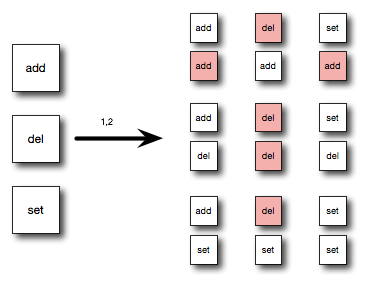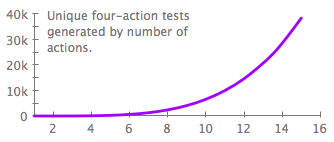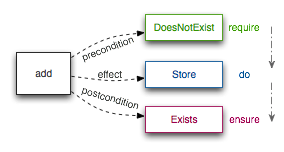How to Test Everything
I recently had a membase user point out a sequence of operations that led to an undesirable state. I’ve got a lot of really good engine tests I’ve written, but not this case:
add with timeout -> wait for timeout -> add with timeout
The bug is pretty straightforward – expiry is lazy and it turns out I’m not checking for expiry in this case. It was pretty easy to write this test, but immediately made me think about what other cases weren’t being run.
Now, I know there are countless tools out there to aid in testing. I’ve written another one. I probably spent an hour or so writing a framework to write and run all of the tests I needed. The difference between what I’m describing here and, for example, quick check is that I want something very simple to express actions that expect their environment to be in a particular state and will leave the environment in another state. Then I want to hit every possible arrangement of these actions to ensure they don’t interfere with each other in unexpected ways.

This blows up very quickly – specifically the number of tests
generated for a test sequence of n actions from a possible actions
is approximately an.
Consider three defined actions permuted into sequences of two. That blows out to nine possibilites as shown in the diagram on the right.
The actions in the diagram are defined with memcached semantics on a
single key, so add has a prerequisite that the item must not exist
and del has a prerequisite that the item must exist.
The generated test expects success at each white box, failure at each red box, and tracks the expected state mutations to build assertions.

My first test… um, test ran with 11 actions in sequences of 4
actions. I have more actions to go, but 4 is a pretty good length,
so the chart at the left is going to demonstrate my growth rate.
The awesome part is that it pointed out the original bug quite easily and another couple of bugs with limited effort.
How Do I Use This?

The API is so far pretty simple and composable. There are basically five classes (three are shown in the image on the right).
Condition
A Condition is a simple callable that is used for preconditions and
postconditions. A given class doesn’t care which one it’s used for,
and in many cases will be used for both.
For example, consider my implementation of DoesNotExist:
class DoesNotExist(Condition):
def __call__(self, state):
return TESTKEY not in stateEffect
An Effect changes our view of the state (and depending on the
driver, may actually cause something in the world to change with it).
For example, the StoreEffect works as follows:
class StoreEffect(Effect):
def __call__(self, state):
state[TESTKEY] = '0'Action
An Action brings together an Effect and one or more Condition
classes as pre and post conditions. For example, we’ll look at two
actions, an Add action and a Set action:
class Set(Action):
effect = StoreEffect()
postconditions = [Exists()]
class Add(Action):
preconditions = [DoesNotExist()]
effect = StoreEffect()
postconditions = [Exists()]The interesting part of this is that Set and Add have different
semantics, but are expressed as different compositions of the same
Conditions and Effects.
Driver
Driver is kind of a larger part (seven defined methods!). It does
enough that I can do anything from generate a C test suite for
memcached engines all the way to actually executing tests across a
remote protocol.
I won’t describe the entire thing here since it’s documented in the source. I will however, close the loop by showing you some example code that it generated that demonstrated the error we failed to find in the first place:
static enum test_result test_add_add_delay_add(ENGINE_HANDLE *h,
ENGINE_HANDLE_V1 *h1) {
add(h, h1);
assertHasNoError(); // value is "0"
add(h, h1);
assertHasError(); // value is "0"
delay(expiry+1);
assertHasNoError(); // value is not defined
add(h, h1);
assertHasNoError(); // value is "0"
checkValue(h, h1, "0");
return SUCCESS;
}That demonstrates how much information you know at each step of the way. From there, we can do all kinds of stuff with our stubs (delay above is implemented with the memcached testapp “time travel” feature, for example).
From here, it’s less exciting. We provide constraints, it writes tests, and makes sure that there’s another area that it’s impossible for users to encounter something we haven’t seen before.
